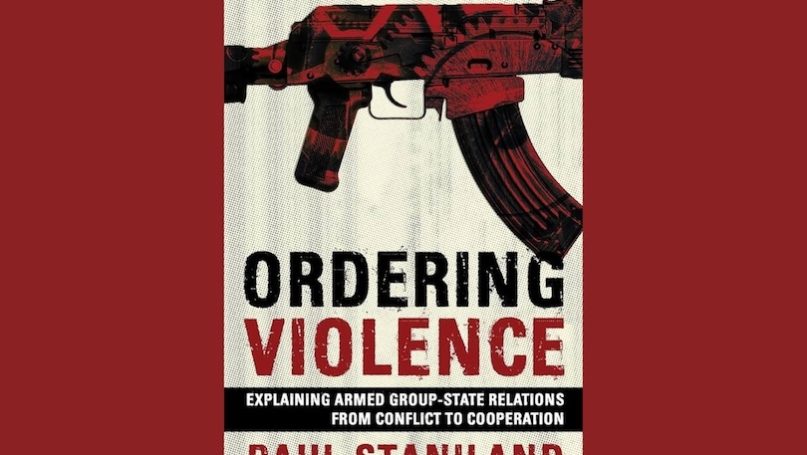
Ordering Violence: Explaining Armed Group-State Relations from Conflict to Cooperation
By Paul Staniland
Cornell University Press, 2021
Paul Staniland is one of the leading scholars of armed conflict today. His Ordering Violence is a deeply sophisticated book that builds and expands upon Staniland’s past work, including his influential 2012 article “States, Insurgents, and Wartime Political Orders.” Ordering Violence considers how and why states confront, cooperate with, contain, or otherwise interact with armed groups. Even to pose this question represents a considerable advance over much thinking within political science’s current civil wars literature, which sometimes crudely assumes binary conflict between incumbents and rebels. Staniland shows that matters are in fact much more complex. He groups the relations that arise between states and armed groups into four armed orders: “total war, containment, limitation cooperation, and alliance” (p.3). Attempting to explain why such orders may emerge at different moments, Staniland looks to how “the ideological threats that governments perceive from armed groups drive state responses” (p.2).
Staniland refreshingly argues for “taking ideas seriously” (p.262). He pushes back against the frequent caricature of contemporary warfare which holds that “there is no ideology, no politics beyond that of greed and survival” (p.263) It is unfortunate, however, that he then goes on to uncritically accept other scholars’ depictions of Africa as meeting this “greed and survival” model (I revisit the applicability of Staniland’s ideas to West Africa below). In addition to giving weight to ideological alignment or competition between states and armed groups, Staniland also pays attention to change over time, and how certain events—such as “militarized elections”—can produce tactical cooperation between competitors, thereby making them “strange bedfellows” (p.40).
Beyond the introduction and the two theoretical chapters (“The Politics of Threat Perception” and “How Armed Orders Change”), the core of the book consists of a discussion of Staniland’s Armed Orders in South Asia dataset (Chapter 3), and then respective case studies for India, Pakistan, Burma/Myanmar, and Sri Lanka (Chapters 4-7). The case studies showcase Staniland’s keen attention to history; he delves deep into the colonial past and highlights numerous political and conflict phases within each country—thereby providing considerable texture that the dataset cannot capture. The book’s conclusion strikes a note of humility regarding limitations to Staniland’s arguments (particularly regarding “the mechanisms of armed group agency,” p.261). Staniland also reflects on the book’s implications for theory and policy, notably claiming that “ceasefires, live-and-let-live deals, and active collaboration can all limit conflict and protect civilians from the worst excesses of open warfare” (p.273). This is a sobering but pragmatic suggestion: totalizing peace deals are not the only way to save lives, and such deals may not usually be in the offing.
How well do Staniland’s ideas hold up when applied to a different part of the world—West Africa, for example? The utility of Staniland’s typologies is clear: his four-part model of different armed orders could productively be applied to conflicts in the Sahel and in Nigeria, as could his explanation of how different combinations of “ideological fit” and “tactical overlap” may produce different forms of armed order. “Strange bedfellows” are also abound in the region.
At the same time, however, things are even messier than Staniland’s typologies show—and so much information remains inaccessible to researchers that any typologizing must be provisional, probabilistic, and limited. Is it possible, for example, that multiple orders exist simultaneously within the “Boko Haram” conflict in northeastern Nigeria? Rumors fly about concerning the wartime political economy, and about relationships between local politicians and armed groups; meanwhile, civilians and military officers are sometimes in open disagreement, to say nothing of occasional signs of tension within the military hierarchy itself. Is it possible that both “total war” and “limited cooperation” are occurring simultaneously, depending on which localities one is examining and which actors one is discussing? Even in Staniland’s careful analysis, there is sometimes a lapse into what some political scientists call the “unitary actor fallacy”—that is, the projection of cohesion and singular motives and goals onto states and organizations. The unit of analysis in much of Staniland’s book is governments and armed groups, rather than individuals or factions; when individuals enter his narrative, it is often leaders at the top. Similarly, although Staniland makes change over time a central part of his analysis, change in Nigeria and the Sahel has sometimes been so quick that I am not convinced any data set could capture the complexity of events and shifts. In Mali, the year 2020 alone saw mass protests, a military coup, jihadist infighting, a jihadist kidnapping of a major politician and then the subsequent negotiation of his release, and more. Such complexity cannot be coded without tremendous reductionism—which is precisely why case studies are so crucial.
This brings me to one last critique of the book. As someone originally trained in the humanities, I found Staniland’s case studies to be highly detailed but thinly sourced. In each case, and particularly those discussed in Chapters 5-7, the references centered around a relatively small number of secondary works. Staniland does draw on some primary sources—Jawaharlal Nehru’s letters are extensively cited, as are the diaries of Muhammad Ayub Khan—but the reader hears relatively little from conflict actors in their own words. For a book that “takes ideas seriously,” the protagonists might have also been taken more seriously. Incorporating their voices would perhaps have shifted the analysis in interesting ways.
On the whole, Ordering Violence will stand as an anchor work in the increasingly complex and compelling political science literature on civil wars and armed conflict. Staniland’s central insight—that there is more to war than fighting—has deep implications for how to understand the relationships between states and those that they fight, or, in many cases, make deals with.